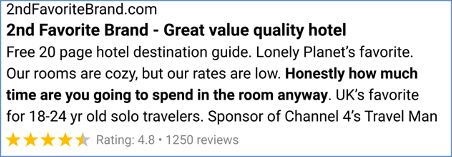

J&C Blog
Find all the latest marketing trends on the J&C Blog.

Find all the latest marketing trends on the J&C Blog.
Today’s online shoppers face an ever-growing number of choices and mountains of information as they traverse the long and winding path toward a purchase.
Well recent research from Google has revealed that there are some specific strategies to help marketers make sense of what’s often referred to as the “messy middle” of that purchase journey. And it may help your brand land in the right place with the right messaging to the right shopper at the right time.
The insights came from a research study known as Decoding Decisions. The findings were then applied to Google search ads. Google showed 96,000 simulations to 12,000 shoppers featuring 12 products to figure out what makes an ad stand out on a search results page (SERP).
Key Finding #1: Be present where people are searching
The Google research showed that you can capture consumer preference just by showing up as people search. Ok, that’s fairly obvious, but to isolate the impact, they simulated the search results using identical ad copy for both the shopper’s favorite and next favorite brands.
The result was pretty surprising. When shoppers who were searching for moisturizers, saw an ad featuring their second favorite brand pop into the search results, it immediately captured 31% of ad clicks. And that’s despite ranking third on the page and showing up below their favorite brand.
Key Finding #2: You don’t have to show up on the top of the page to be considered — just being present can make a difference.
But here’s an interesting twist…
Shoppers were also shown three different ads on a simulated search results page. It looked just like a Google search results page in the real world. One ad was for their preferred brand. Another ad for their second favorite brand. And a third ad that was completely fictional, but in the same product category.
The difference here was that five behavioral science principles were used to alter the copy on two of the ads. The objective was to see if this would be enough to move consumers’ interest away from their favorite brand.
The 5 behavioral science principles applied were:
Copy for the ads was changed to test the different principles. But would the reader’s preference be shifted away from their favorite brand?
Key Finding #3: When used strategically (and responsibly), behavioral science principles can be used to win and defend consumer preference in the “messy middle.”
So yes, applying one or more of these biases shifted the brand preference. But researchers took it a step further. If applying one of these biases made a difference, what would shoppers think if they saw “supercharged” versions of their second favorite and fictional brands?
A new ad using the most effective versions of each bias was created. Here’s an example:

Line 1: Power of Free bias – Free 20-page hotel destination guide.
Line 2: Authority bias – Lonely Planet’s favorite.
Line 3/4: Framing bias – Our rooms are cozy, but our rates are low. Honestly, how much
time are you going to spend in the room anyway.
Line 5: Social proof bias – UK’s favorite for 18-24 yr old solo travelers.
Line 6: Costly signaling bias – Sponsor of Channel 4’s Travel man.
Now in Line 3, the Framing bias used is actually known as the pratfall effect. This is a framing bias that states when you honestly admit a flaw in your product, it can humanize your message, increase likability, even build trust. In the “super” ad, the flaw is deliberately highlighted to help frame it as a benefit.
So by calling the hotel rooms “cozy,” which we all know can be a code word for “small,” the ad is playing up the hotel’s value. And mentioning that “you’re likely not going to spend much time in the room anyway” reinforces the idea.
The copy took an honest look at an imperfection — a tiny room — and “framed” it as a being a benefit. And the results from this “supercharged” ad? Well, they were the best yet. Truth be told though; it takes a fair bit of testing to create a supercharged ad.
But that’s what’s great about these behavioral principles — they are test-able across different channels. That is, you can test these same techniques in your direct mail copy. And in doing so, create a supercharged direct mail piece.
In our world, that’s called a “control package.” And it’s one of the things J&C does best. For years, J&C has used these principles (or variations of them), combined with a Test — Learn — Refine strategy. It’s an approach that’s helped us establish long-standing control packages for our financial, auto insurance, Medicare, energy, and retail clients.
The fact is, “supercharging” copy in a search ad is not much different than supercharging the copy in a letter, or on an OE or on a buckslip.
The process and principles outlined above help you capture the reader’s attention… address a basic human need… establish trust… and offer a compelling reason to respond. It’s extremely effective.
Final Thoughts: GET TESTING.
The old adage is true — If you’re not testing, you’re not trying. You can start making the kinds of changes outlined above right now — today. Test them. Because every time test you learn something.
Test. Learn. Refine. That’s the name of the game. Whether you’re looking for help setting up an effective test matrix or need to supercharge your direct mail package, contact J&C.
At J&C, our expertise lies in our mastery of the art and science of customer engagement. Helping clients improve their response rates and marketing ROI is our specialty. Contact J&C today.
-------------
J&C helps direct marketing professionals create highly responsive direct mail campaigns that generate improved response rates, more revenue, and better ROI. And it’s all done using our proven philosophy known as the "Inverted Pyramid." Our mission is to shatter response rates for financial, insurance, and any other
companies in the regulated and restricted products market.
Topics: Direct Marketing, Direct Mail, Creative
303 E Wacker Drive, Suite 2030
Chicago, IL 60601
Phone: 312-894-3000
Fax: 312-894-3005